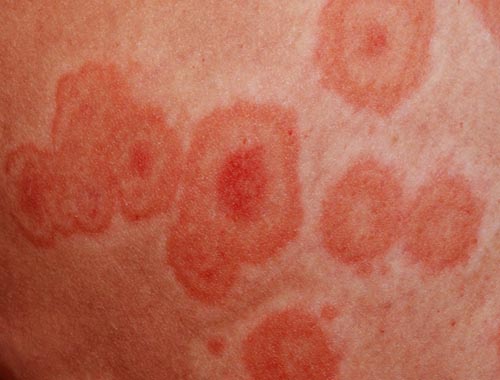Erythema multiforme
Erythema multiforme is a skin disorder due to an allergic reaction or infection. Erythema multiforme is a type of hypsersensitivity reaction that occurs in response to medications, infections, or illness. Medications include: Barbiturates; Penicillins; Phenytoin; Sulfonamides; Infections include: Herpes simplex; Mycoplasma; The exact cause is unknown. The disorder is believed to involve damage to the blood vessels of the skin, followed by damage to skin tissues. Some forms of this condition are more severe than others. Erythema multiforme minor is not very serious. Most erythema multiforme is caused by herpes simplex or mycoplasma infections. Erythema multiforme major is more severe, and is known as Stevens-Johnson syndrome. The more severe form is usually caused by reactions to medications, rather than infections. Erythema multiforme occurs primarily in children and young adults. Characterized by target lesions that resemble a bull's eye. These usually erupt over 24 to 48 hours and last for 1 to 2 weeks. Typically presents in a symmetrical distribution of lesions over the dorsal surfaces of the extensor extremities with minimal mucous membrane involvement. Generally related to infectious diseases and not drug exposure. The most commonly associated infections are herpes simplex virus and Mycoplasma pneumoniae. Other associated infections include hepatitis B, Epstein-Barr virus, cytomegalovirus, histoplasmosis (with concomitant erythema nodosum), orf (parapox virus that can be transmitted from sheep or goats to humans), coccidiodomycosis, Kawasaki disease, and gardnerella. Associated drugs include aminopenicillins, docetaxel, TNF-alpha inibitors, antimalarials, anticonvulsants, and lidocaine injections. Statin medications have been associated with photo-induced lesions. Hepatitis B vaccine and allergic response to contact allergens have also been known to elicit the disorder. Supportive care and treatment of underlying infection remain the mainstay of therapy.
